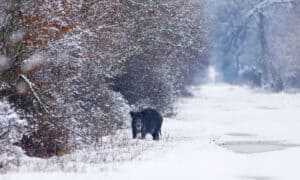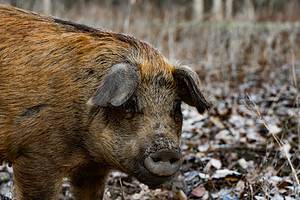Dangerous, rapidly multiplying invaders are spreading across the United States. So far, only 10 of the 50 states have escaped them. This invasive species is the wild boar. Eons ago, wild pigs lived in Eurasia, not North America. When they roamed free across that vast, sparsely populated landmass, plenty of wolves and bears controlled their numbers. Since they were introduced into North America, wild predators have drastically declined, as the land has been settled and urbanized. And fewer predators mean more pigs. Wild pigs, with anywhere from four to eight young in each litter, are multiplying rapidly. Are there wild boars in Washington State? Why are they dangerous, and what can be done about them?

Feral pigs multiply rapidly, giving birth to four to eight young per litter.
©Slatan/Shutterstock.com
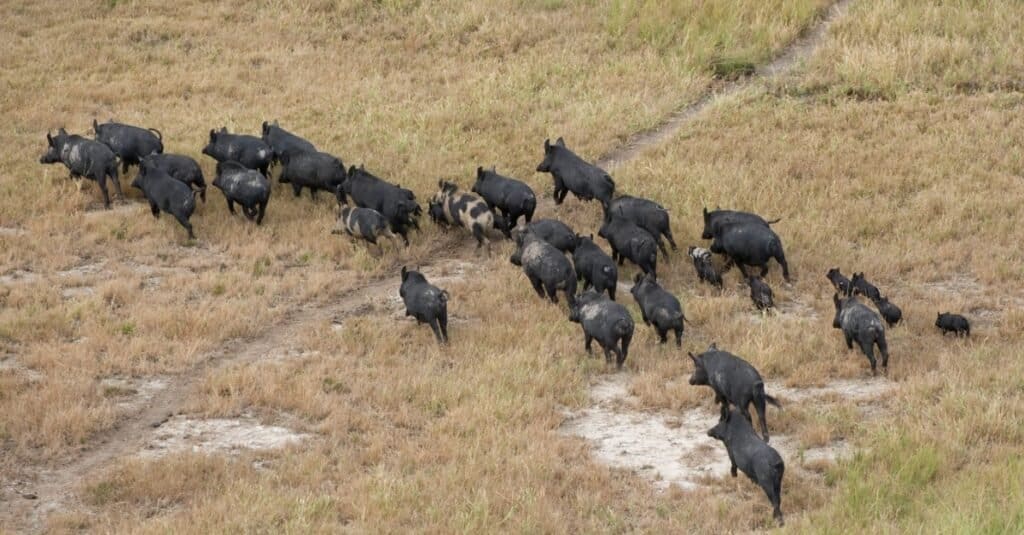
Feral pigs roam in large herds and can damage a lot of property in a short time.
©iStock.com/JohnCarnemolla
What Do Wild Pigs Look Like?
Wild boars go by different names, including razorbacks, wild pigs, wild hogs, feral pigs, or feral hogs. Technically, the term “boar” only applies to males. However, “wild boar” is often used as a more general term for the species as a whole.
A female can weigh anywhere from 77-330 pounds, and males range from 130-440 pounds. They have course, long-bristled hair that is usually black. It can also be grey, brown, tan, or red and can be solid or spotted. They also have long snouts. Males have 3-5-inch-long tusks that can be deadly to their adversaries.
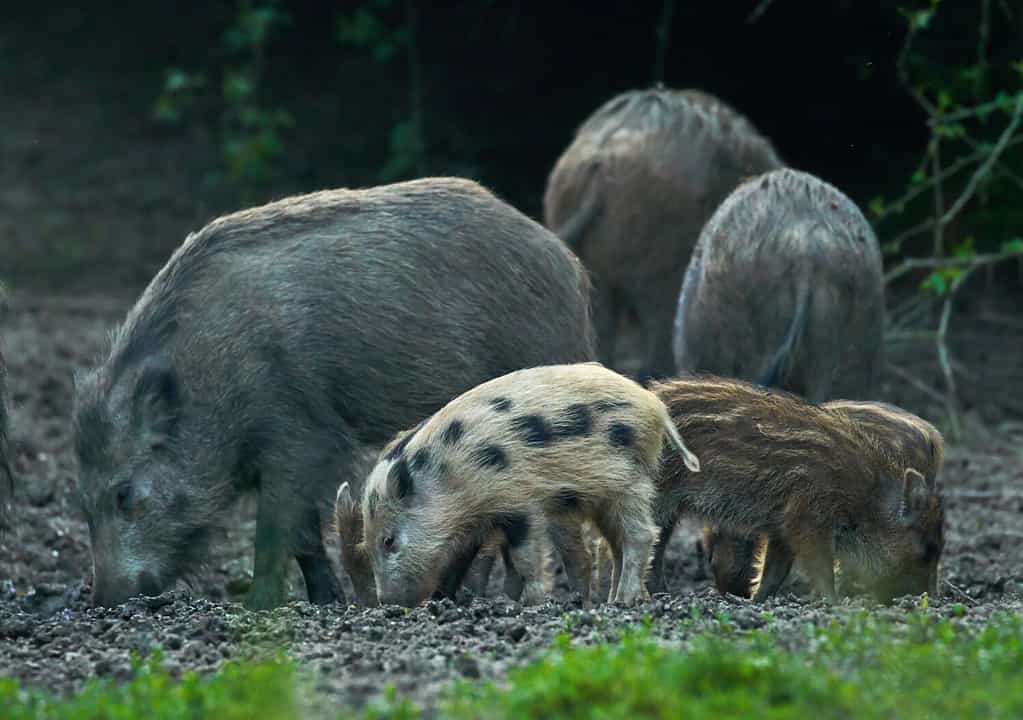
Wild pigs are most typically solid black but can come in other colors and spotted or striped as well.
©Slatan/Shutterstock.com
How Did Feral Hogs Arrive in North America?
Swine are indigenous to Eurasia. However, they were brought to the New World in the 15th century by none other than Christopher Columbus. He, along with many other explorers, decided to release domestic pigs into the wilderness. The idea was for them to multiply as a local food source that future expeditions could hunt to feed themselves. As more colonists arrived and set up farms, occasionally domestic pigs escaped and join the wild herds.
In more recent years, wild pigs have escaped from game reserves. At times, they have been deliberately and illegally released by hunters to create populations for hunting. Southern states such as Texas, Oklahoma, and Louisiana have the most feral pigs. However, these animals are hardy enough to survive in the Northern United States and even Canada. It’s estimated that the current national population may be as high as seven million.

Wild boar can survive even under the harsh winter conditions of Canada.
©iStock.com/Jevtic
How Many Feral Hogs Are in Washington?
Well here’s good news for Washington State. Wildlife officials say that to their knowledge, the state does not have any feral hog herds. That does not mean Washingtonians can relax their vigilance, though. Neighboring Idaho found one group of pigs and exterminated them. It’s always possible for wandering herds to cross over to Washington as well. Ominously, to the south, Oregon has as many as 200 feral hogs that have migrated from California, where there are hundreds of thousands.

It would be hard to track wild boar in Washington. They won’t be noticeable without a substantial herd.
©iStock.com/chingkai huang
Why Are Feral Pigs a Problem?
Although feral pigs are not a problem in Washington State yet, in the states that are battling this species, they create enormous problems.
Aggressive Temperament
Feral pigs have an aggressive temperament and behave in ways that are hard to predict. For example, when faced with an animal bigger than they are, it’s impossible to tell whether they will run away or attack, as they have been known to fearlessly charge at threats much larger than themselves. They’re territorial and fiercely protective of their young. They are especially aggressive during mating season. Males and females both have sharp teeth, but boars also have sharp curved tusks that can grow 3-5 inches long. They use these not only to drive off enemies of other species, but to fight one another during mating season, and to slaughter prey.
Swine are omnivorous and are known to kill and eat small mammals, snakes, birds, and even larger animals such as lambs, calves, and fawns. It’s quite possible for them to kill pets, children, or even adults by goring and savagely biting. If you encounter a wild pig while hiking in the woods, or even on your own property, it’s important to back away immediately and get to shelter or even climb up a tree if you are being chased.
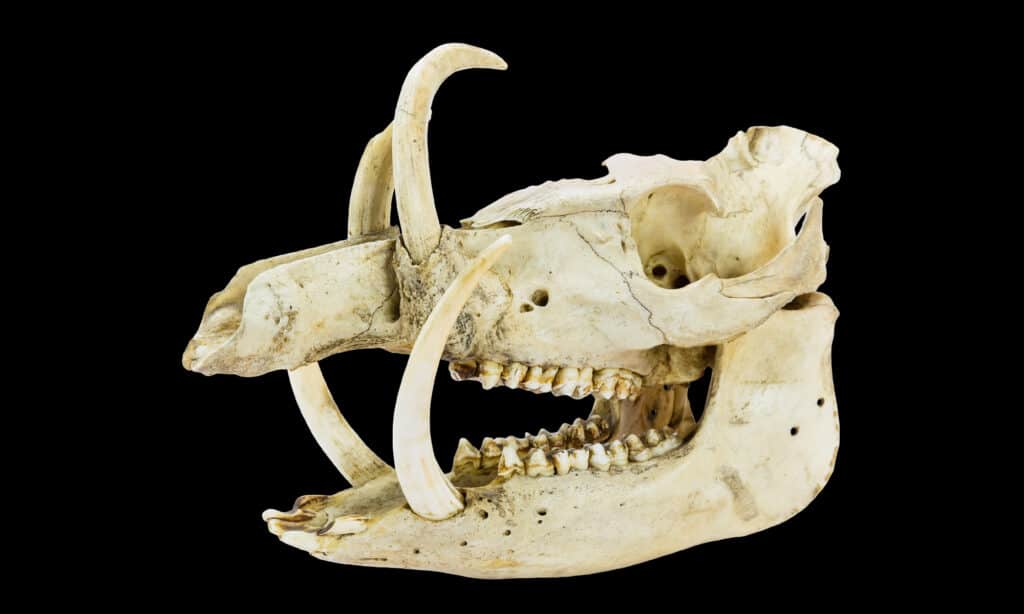
This skull looks prehistoric, but it is actually a modern wild boar. Its tusks and teeth can be deadly.
©iStock.com/Ben-Schonewille
Disease Carriers
Studies of wild boar have shown they can be infected with 34 different serious diseases. Part of this is that they eat virtually any kind of plant or animal and root around in the ground and in outdoor water sources. They are basically picking up germs from every possible source around them. Animals and people can contract some of these illnesses by eating improperly prepared wild pork, being bitten or in close contact with a feral hog or drinking contaminated water. An example of a disease that particularly concerns pig farmers is swine flu, which was finally eradicated in 1978 after years of effort. It is deadly to pigs. If it were to reemerge among feral swine herds, it could spread quickly across the country and decimate domestic herds that come into contact with wild pigs.

Wild swine carry dozens of diseases that can be transmitted to pets or people through close encounters.
©David Dohnal/Shutterstock.com
The Bane of Farmers
Farmers hate wild pigs not only because they can damage domestic swine herds, but because of all the other damage they do to crops and infrastructure. They will eat any sort of crop – grains, fruits, vegetables – and will break down fences or root under them to get to what they want to eat. They will also break into animal pens to attack smaller animals. Pigs carry parasites that make their skin itchy, so they like to scratch themselves against tree trunks, fence posts, or vines. It strips the bark off of trees and plants, exposing them to disease and damaging insects.
Without a doubt, a pig’s favorite thing to do is to root and wallow in the mud, turning the soil over, and looking for tasty roots, fungi, ground-nesting birds, snakes, and rodents to eat. They can make short work of a well-manicured lawn, landscaping, or pasture. They have been known to damage golf courses, cemeteries, and suburban backyards where repairing the damage to sod and plantings is expensive. According to the U.S. Department of Agriculture, feral pigs cause over $1.5 billion in damage every year to farms in the United States.

Feral pigs damage a great deal of property in their constant quest for food.
©iStock.com/JMrocek
Ecological Damage
The damage inflicted by wild hogs extends to the natural ecosystem. They root around the forest floor, eating and driving off ground-dwelling species, killing low-growing plants, seedlings, and saplings. On average, biodiversity in forest habitats declines by 25% when feral hogs move in and turn the forest floor into a sea of mud where nothing can grow. Pigs also love to wallow in the mud next to ponds and streams to cool off on hot days. In so doing, they contaminate the water with mud, feces, and urine, making it undrinkable as long as they are in the area. And of course, if they stay for long, this reduces the freshwater biodiversity by killing and driving away fish, frogs, turtles, and other species.
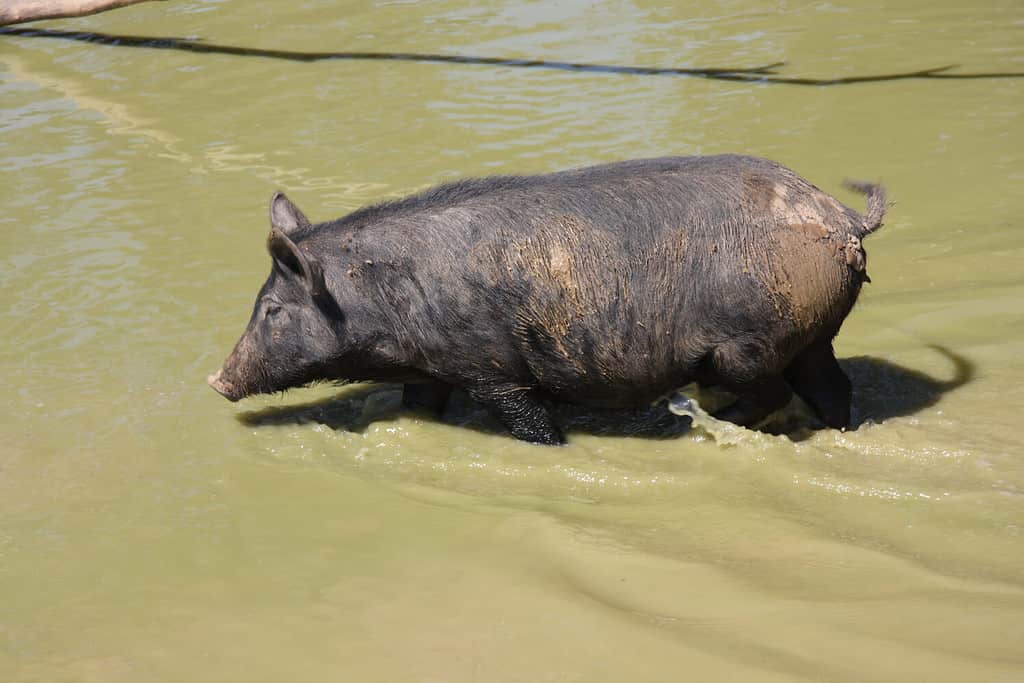
Feral pigs turn the forest floor and water sources into a muddy mess, unusable by other species.
©Auldist/Shutterstock.com
What Can Be Done About Feral Hogs?
Monitoring
Even though wild boars in Washington are not an issue right now, wildlife officials are remaining vigilant to ensure herds don’t cross over from other states or that feral hogs are not released illegally by hunters. States that do have a feral hog problem track them with the help of citizen reports, tracking efforts, sometimes using canines or aerial surveillance, noticing areas of feral hog damage to property and the environment, and using trail cameras. Feral hogs are most easily detected, of course, when they are in herds than just a few isolated swine that can hide more easily.
Fencing
Property owners can protect themselves by investing in fencing, but it’s expensive and requires ongoing maintenance. It has to be strongly constructed to keep out a group of 400-pound animals repeatedly trying to get through. To keep them from rooting under it, barbed wire is used at the bottom and buried several feet underground. Sometimes electrified fencing is used.
Hunting
There is no hunting season for wild boars in Washington because it officially does not have a wild boar population. Anyone spotting one should report it to wildlife officials. Some states allow hunting wild boar and others do not. There’s a case to be made on both sides. Hunting is how other prolific animal populations, such as deer, are effectively controlled in many parts of the country. It removes a problem from the environment, creates recreation for hunters, and provides families with a food source. However, in the case of wild boar, there’s a case to be made that hunting is not the best solution. Here are some reasons:
- It can frighten herds, change their behavior and scatter them. They’re highly intelligent. They can become better at concealing themselves or can spread into other areas where they may do even more damage than the place they are.
- Improperly handled carcasses and inadequately cooked pork can pose a danger of disease outbreaks.
- In states where boar hunting is allowed, game reserves have been set up that have brought boar into the state that have sometimes escaped, and some individuals have illegally released feral pigs into the wild to create breeding populations for hunting.
So then, paradoxically, hunting wild boar might actually be one of the factors that have caused them to proliferate across the country. Nonetheless, in many states it is legal. So, if you are a hunter and want to find a place to hunt wild boar legally, there are at least 28 states that allow it, and you can learn more about their policies. Please just don’t bring any pet piglets home with you! Not only is it wrong ecologically, it’s also illegal.
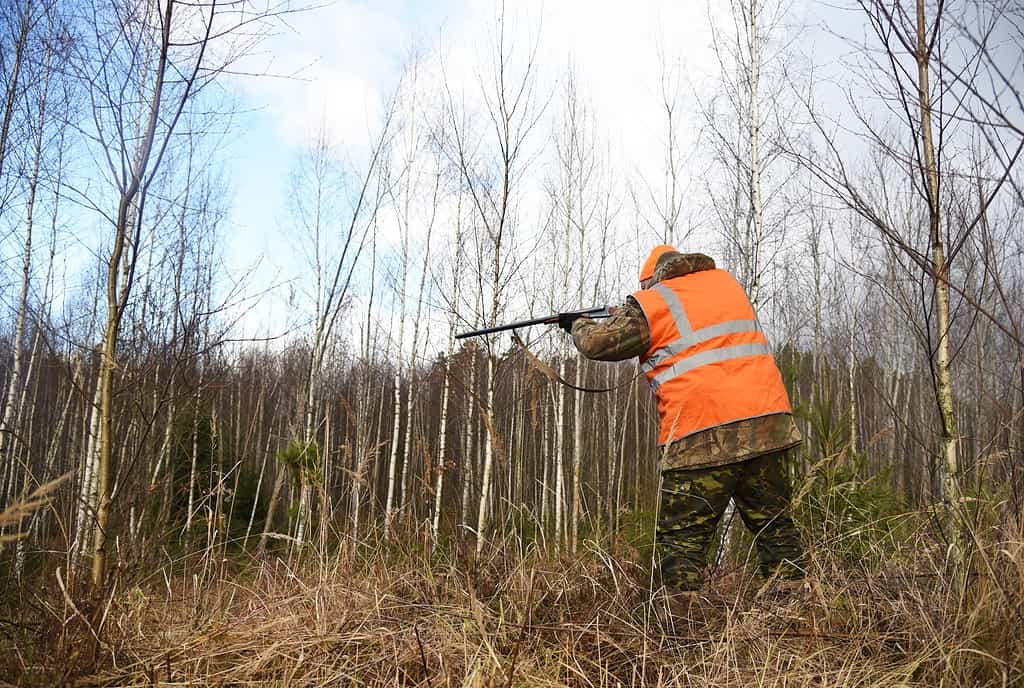
This hunter has tracked down a wild boar and is preparing to take his shot.
©Maksim Safaniuk/Shutterstock.com
Trapping
Many wildlife officials believe that trapping is a better alternative. One trapper can manage a large number of traps spread across a wide area, and they work day and night as long as they are regularly checked and reset. One of the problems with traps is that no matter how much they may be designed to make it more likely to catch only the animal you are trying to catch, there is always the possibility of checking your traps and finding the wrong species there.
Poisoning or Sterilization
It’s possible to put out hog feed for the invaders in areas they frequent that can either poison them or sterilize them (temporarily). Poisoning is better in the sense that for the pig that’s killed, it’s a permanent solution to that part of the problem. However, it does introduce a toxic substance into the environment and needs to be used with caution and monitoring of any ecological side effects. The other possibility is to lace the feed with special contraceptives that cause male hogs to be infertile for one month. Obviously, the problem with this is that it is only a temporary fix and must be repeated monthly indefinitely. However, even if the exact same hog was not sterilized every month, having a random rotation of males experience infertility some months out of the year can, in the big picture of the herd reduce the number of piglets born.
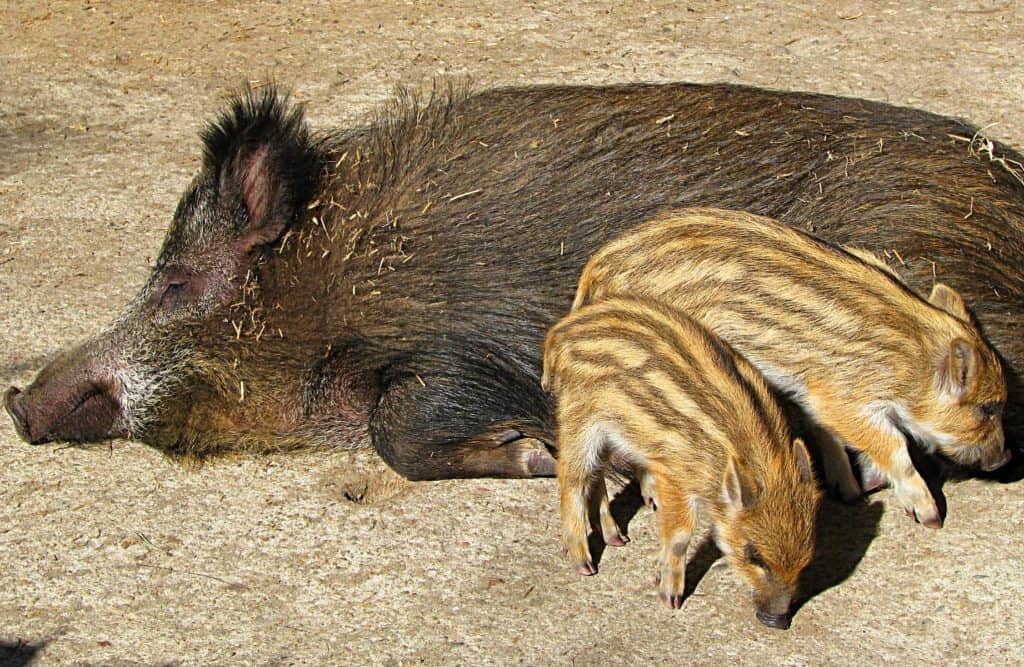
Contraceptive-laced pig feed can reduce feral hogs’ ability to reproduce.
©Jarosław Pocztarski / CC BY 2.0 – License
What’s the Solution?
Wild boars in Washington and around the country are a manmade problem that will ultimately require a manmade solution. People introduced them and are responsible for much of their spread. If we take a hands-off approach, they will continue to multiply and spread destruction. The only alternative to people exterminating feral hogs would be to allow the population of natural predators to increase to take care of the problem for us. But few of us would feel good about another several million wolves, bears, and mountain lions roaming our farms and neighborhoods at night. So, it’s up to people to continue studying and monitoring these creatures and find the most humane and effective ways to remove them from the environment, or at least contain them in some dedicated habitats where they will not be able to spread their own unique brand of chaos.
The photo featured at the top of this post is © Michael Gabler / Creative Commons / Original
Thank you for reading! Have some feedback for us? Contact the AZ Animals editorial team.



